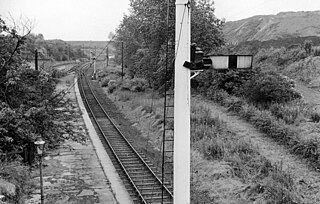
The District line is a London Underground line running from Upminster in the east and Edgware Road in the west to Earl's Court in west London, where it splits into multiple branches. One branch runs to Wimbledon in south-west London and a short branch, with a limited service, only runs for one stop to Kensington (Olympia). The main route continues west from Earl's Court to Turnham Green after which it divides again into two western branches, to Richmond and Ealing Broadway.

The London and North Western Railway was a British railway company between 1846 and 1922. In the late 19th century, the LNWR was the largest joint stock company in the world.

The Rushden, Higham and Wellingborough Railway is a heritage railway operated by the Rushden Historical Transport Society in the town of Rushden in the county of Northamptonshire, England.

The Breckland line is a secondary railway line in the east of England that links Cambridge in the west to Norwich in the east. The line runs through three counties: Cambridgeshire, Suffolk and Norfolk. It takes its name from the Breckland region of Norfolk and passes through Thetford Forest.

The Patriot Class was a class of 52 express passenger steam locomotives built for the London Midland and Scottish Railway. The first locomotive of the class was built in 1930 and the last in 1934. The class was based on the chassis of the Royal Scot combined with the boiler from Large Claughtons earning them the nickname Baby Scots. A total of 18 were rebuilt to create the LMS Rebuilt Patriot Class between 1946 and 1948; thereafter those not subjected to rebuilding were often referred to as the Unrebuilt Patriot Class. These remaining 34 unrebuilt engines were withdrawn between 1960 and 1962.

St Denys railway station serves the St Denys and Portswood suburbs of Southampton in Hampshire, England. It is 77 miles 10 chains (124.1 km) down the line from London Waterloo.

The London Midland and Scottish Railway (LMS) Fowler Class 4F is a class of 0-6-0 steam locomotive designed for medium freight work. They represent the ultimate development of Midland Railway's six coupled tender engines. Many trainspotters knew them as "Duck Sixes", a nickname derived from their wheel arrangement.

The Royal Scot was a named passenger express train that ran between London Euston and Glasgow Central on the West Coast Main Line (WCML), with previously a portion also going to Edinburgh.

The South Eastern and Chatham Railway (SECR) C Class is a class of 0-6-0 steam locomotive, designed by Harry Wainwright and built between 1900 and 1908. They were designed for freight duties, although occasionally used for passenger trains. They operated over the lines of the railway in London and south-east England until the early 1960s. One example was rebuilt as an S Class saddle tank.

The Midland Railway (MR) 3835 Class is a class of 0-6-0 steam locomotives designed for freight work. The first two were introduced in 1911 by Henry Fowler. After the grouping in 1923, the designs were slightly modified and continued to be built up to 1941 by the LMS as the LMS Fowler Class 4F.

Langwathby is a railway station on the Settle and Carlisle Line, which runs between Carlisle and Leeds via Settle. The station, situated 19 miles 59 chains (31.8 km) south-east of Carlisle, serves the village of Langwathby, Eden in Cumbria, England. It is owned by Network Rail and managed by Northern Trains.

The Kingston loop line is a railway line built by the London and South Western Railway (L&SWR) in South West London. It was built in two stages, the first of which was opened in 1863 and ran from Twickenham to Kingston. Travel from Kingston to London by that route was a rather circuitous trip. Later, the line was extended from Kingston to Wimbledon in 1869. The line ran independently alongside the Southampton main line from Malden to Wimbledon - where the line connected to other railway lines, which gave access to Ludgate Hill in the City of London, as well as to Waterloo.

The Shepperton branch line is a 6 mi 51 ch (10.7 km) railway branch line in Surrey and Greater London, England. It runs from its western terminus at Shepperton to a triangular junction with the Kingston loop line east of Fulwell. There are intermediate stations at Upper Halliford, Sunbury and Hampton. The branch also serves a dedicated station at Kempton Park racecourse. All six stations are managed by South Western Railway, which operates all passenger trains. Most services run between Shepperton and London Waterloo via Kingston, but during peak periods some run via Twickenham.

Whitchurch Town railway station was a station on the Didcot, Newbury and Southampton Railway in England. It served the town of Whitchurch, Hampshire, between 1885 and 1960.
Whittington railway station is a former railway station on the southern edge of New Whittington, Derbyshire, England.

The London and North Western Railway (LNWR) Claughton Class was a class of 4-cylinder express passenger 4-6-0 steam locomotives.

Bolsover Castle is a former railway station in Bolsover, Derbyshire, England.

Palterton and Sutton is a former railway station between Palterton and Sutton Scarsdale, Derbyshire, England.

Glapwell is a former railway station in Glapwell, Derbyshire, England.
The Doe Lea branch is a mothballed railway line in Derbyshire, England. It connected the Derbyshire towns of Chesterfield, Staveley and Bolsover to the Nottinghamshire town of Mansfield. It also had a branch line to Creswell via the Derbyshire town of Clowne.


















